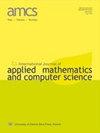用多维区间算法求解区间线性方程组的现实容错解
IF 1.2
4区 计算机科学
Q3 AUTOMATION & CONTROL SYSTEMS
International Journal of Applied Mathematics and Computer Science
Pub Date : 2023-06-01
DOI:10.34768/amcs-2023-0018
引用次数: 0
摘要
摘要本文给出了区间线性方程组解鲁棒性的一种确定方法。该方法也可以应用于迄今为止无法找到解或以不适当间隔形式获得解(在实践中无法实现)的ILE系统。作者进行的研究表明,对于许多问题,不可能得出对数据不确定性完全可靠的理想解决方案。但是,可以得到部分鲁棒解,并选择鲁棒性最高的解进行应用。本文表明,可以根据单个方程的鲁棒度来计算整个系统对不确定性的鲁棒度,从而大大简化了计算。通过一系列示例(也包括基准示例)来说明所提出的方法,以促进其理解。它是作者先前发表的一阶ILEs方法的扩展。本文章由计算机程序翻译,如有差异,请以英文原文为准。
A Realistic Tolerant Solution of a System of Interval Linear Equations with the Use of Multidimensional Interval Arithmetic
Abstract The paper presents a method of determining the robustness of solutions of systems of interval linear equations (ILEs). The method can be applied also for the ILE systems for which it has been impossible to find solutions so far or for which solutions in the form of improper intervals have been obtained (which cannot be implemented in practice). The research conducted by the authors has shown that for many problems it is impossible to arrive at ideal solutions that would be fully robust to data uncertainty. However, partially robust solutions can be obtained, and those with the highest robustness can be selected and put into practice. The paper shows that the degree of robustness to the uncertainty of the entire system can be calculated on the basis of the degrees of robustness of individual equations, which greatly simplifies calculations. The presented method is illustrated with a series of examples (also benchmark ones) that facilitate its understanding. It is an extension of the authors’ previously published method for first-order ILEs.
求助全文
通过发布文献求助,成功后即可免费获取论文全文。
去求助
来源期刊
CiteScore
4.10
自引率
21.10%
发文量
0
审稿时长
4.2 months
期刊介绍:
The International Journal of Applied Mathematics and Computer Science is a quarterly published in Poland since 1991 by the University of Zielona Góra in partnership with De Gruyter Poland (Sciendo) and Lubuskie Scientific Society, under the auspices of the Committee on Automatic Control and Robotics of the Polish Academy of Sciences.
The journal strives to meet the demand for the presentation of interdisciplinary research in various fields related to control theory, applied mathematics, scientific computing and computer science. In particular, it publishes high quality original research results in the following areas:
-modern control theory and practice-
artificial intelligence methods and their applications-
applied mathematics and mathematical optimisation techniques-
mathematical methods in engineering, computer science, and biology.

 求助内容:
求助内容: 应助结果提醒方式:
应助结果提醒方式:


